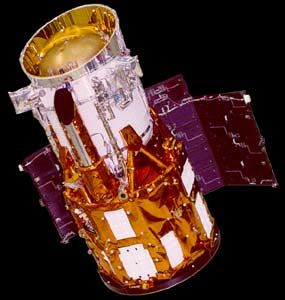
Home - Search - Browse - Alphabetic Index: 0- 1- 2- 3- 4- 5- 6- 7- 8- 9
A- B- C- D- E- F- G- H- I- J- K- L- M- N- O- P- Q- R- S- T- U- V- W- X- Y- Z
WIRE
 WIRE Credit: Manufacturer Image |
AKA: Wide Field Infrared Explorer. Status: Operational 1999. First Launch: 1999-03-05. Last Launch: 1999-03-05. Number: 1 . Gross mass: 254 kg (559 lb).
WIRE was one of two missions selected in 1994 as part of NASA's Small Explorer Program (SMEX). The specific objectives of the WIRE mission were to: (1) determine what fraction of the luminosity of the universe at a red shift of 0.5 and beyond was due to starburst galaxies; (2) determine whether luminous protogalaxies were common at red shifts less than 3; (3) amass a catalogue larger than the IRAS Point Source Catalogue; and (4) make a survey more than 500 times fainter than the IRAS Faint Source Survey at 12 and 25 µm.
The spacecraft used the Small Explorer bus. It was 3-axis stabilized, using a momentum biased control system with 2 arc-minutes pointing. This used reaction wheels, gyros, a star tracker, torque rods, and sun-sensors. The non-articulated solar array provided 170 W orbit average power using GaAs cells and recharged one 9 AHr Super NiCd battery. The control system used an 80386 processor with 88 MBytes memory. Uplink was at 2 kbps, downlink at 18.75, 900, and 1800 kbps using a 5 W S-Band transponder.
Payload was a 30 cm aperture Cassegrain telescope, diffraction limited at 25 µ m, with no moving parts or reimaging optics, feeding two 128 x 128 Si: As BIB focal plane arrays. Optics were cooled to less than 19 Kelvin and detectors were cooled to less than 7.5 Kelvin using 3 kg of solid hydrogen. Instrument power was 35 watts, with an average data rate of 9 kbps. Each exposure lasted 32 - 128 seconds.
The contract for 2 units + options was issued on 17 April 1995.
NASA NSSDC Master Catalog Description
The Wide-field Infrared Explorer (WIRE) was a two-color, solid hydrogen-cooled, infrared imaging telescope designed to study starburst galaxies and to search for protogalaxies. The science goals of WIRE were to: (1) determine what fraction of the luminosity of the universe at a redshift of >0.5 is due to starburst galaxies; (2) assess how fast and in what ways starburst galaxies evolve; and, (3) examine whether luminous protogalaxies are common at redshifts <3. In order to accomplish these goals, WIRE was to conduct a four month survey at 12 and 25 micrometers over an area of between ten and several hundred square degrees of the sky.
The WIRE telescope itself had an entrace aperture of 30 cm and a 32 x 32 arc-minute field of view. It was of a Ritchey-Chretien design with no moving parts and no reimaging optics.
Shortly after launch, while the spacecraft was still tumbling early after orbit insertion, the telescope cover came off prematurely. This resulted in the exposure of the cryogenic materials to light, warming them at a high rate causing outgassing and increasing the rate of spin of the spacecraft beyond the ability of the reaction wheels to slow it. Although ground controllers began work to decrease the excess spin of the spacecraft, they were not able to do so in time to prevent the total loss of the frozen hydrogen used to cool the primary science instrument. Attempts to recover control of the spacecraft were successful, though as a result of the coolant loss no science data were obtainable.
More at: WIRE.
Family: Astronomy, Infrared astronomy satellite, Sun synchronous orbit. Country: USA. Launch Vehicles: Pegasus, Pegasus XL. Launch Sites: Point Arguello WADZ. Agency: JPL, NASA, NASA Greenbelt. Bibliography: 2, 4229, 4230, 6, 13350.
1995 April 17 - .
1999 March 5 - . 02:56 GMT - . Launch Site: Point Arguello. Launch Complex: Point Arguello WADZ. Launch Pad: Aircraft from Vandenberg.. Launch Platform: L-1011. LV Family: Pegasus. Launch Vehicle: Pegasus XL.
- WIRE - .
Nation: USA.
Agency: NASA Greenbelt.
Class: Astronomy.
Type: X-ray astronomy satellite. Spacecraft: WIRE.
Decay Date: 2011-05-10 . USAF Sat Cat: 25646 . COSPAR: 1999-011A. Apogee: 582 km (361 mi). Perigee: 537 km (333 mi). Inclination: 97.50 deg.
NASA's long-delayed WIRE (Wide Field Infrared Explorer) astronomy satellite was the fifth Small Explorer (SMEX) mission managed by NASA-Goddard. The L-1011 Stargazer launch aircraft took off from Vandenberg's runway 30/12 at 01:55 GMT on March 2 for the first launch attempt. The planned 02:56 GMT launch was cancelled at T-46 seconds due to a problem with the tail fin release mechanism of the Pegasus XL launch vehicle. The second attempt was successful, with the Pegaus XL being dropped at 36 degrees N x 123 degrees W over the Pacific Ocean at 02:56 GMT. However the WIRE ran into serious trouble shortly after orbit injection. The cover of the solid hydrogen telescope ejected prematurely, and the cryogenic coolant evaporated and vented, spinning the satellite out of control. WIRE was going to make an infrared photometry survey, generating a large catalog of galaxies and quasars. Air dropped in Point Arguello WADZ.
Back to top of page
Home - Search - Browse - Alphabetic Index: 0- 1- 2- 3- 4- 5- 6- 7- 8- 9
A- B- C- D- E- F- G- H- I- J- K- L- M- N- O- P- Q- R- S- T- U- V- W- X- Y- Z
© 1997-2019 Mark Wade - Contact
© / Conditions for Use